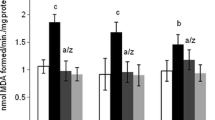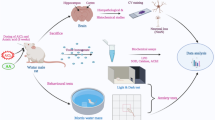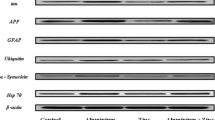Abstract
The present study was aimed to explore the potential of an antidepressant drug lithium (Li) in reducing aluminium (Al) induced neurotoxicity. To carry out the investigations, Al was administered orally (100 mg AlCl3/Kg b wt/day) whereas, Li was administered through diet (1.1 g Li2CO3/Kg diet, daily) for a total duration of 2 months. Al treatment resulted in a significant increase in the activity of enzyme nitric oxide synthase and the levels of l-citrulline which, however, were decreased appreciably following lithium supplementation. Al treatment also revealed an increase in DNA fragmentation as evidenced by an increase in number of comets. Interestingly, Li supplementation to Al treated rats reduced the damage inflicted on DNA by Al. Ultrastructural studies revealed an increase in chromatin condensation with discontinuity in nuclear membrane in both the cerebrum and cerebellum of Al treated rats which showed improvement following Li supplementation. Alterations in the structure of synapse and mitochondrial swelling were also seen. The present study shows the potential of Li in containing the damage inflicted by Al on rat brain.





Similar content being viewed by others
References
Aghdam Y, Barger S, Steven W (2007) Glycogen synthase kinase-3 in neurodegeneration and neuroprotection: lessons from lithium. Curr Alzheimer Res 4(1):21–31 (11)
Amador FC, Santos MS, Oliveira CR (2001) Lipid peroxidation and aluminium effects on the cholinergic system in nerve terminals. Neurotox Res 3(3):223–233
Azzaoui FZ, Ahami AO, Khadmaoui A (2008) Impact of aluminum sub-chronic toxicity on body weight and recognition memory of wistar rat. Pak J Biol Sci 11(14):1830–1834
Baydar T, Papp A, Aydin A, Nagymajtenyi L, Schulz H, Isimer A, Sahin G (2003) Accumulation of aluminum in rat brain: does it lead to behavioral and electrophysiological changes? Biol Trace Elem Res 92(3):231–244
Becaria A, Campbell A, Bondy SC (2002) Aluminum as a toxicant. Toxicol Ind Health 18(7):309–320
Bhalla P, Dhawan DK (2009) Protective role of lithium in ameliorating the aluminium-induced oxidative stress and histological changes in rat brain. Cell Mol Neurobiol 29(4):513–521
Bhalla P, Nair P, Garg ML, Dhawan DK (2009) Effects of lithium on membrane fluidity and lipid profile in brain membranes of aluminium treated rats. Toxicol Environ Chem 1029-0486 91(4):723–733
Bondy SC, Kirstein S (1996) The promotion of iron-induced generation of reactive oxygen species in nerve tissue by aluminium. Mol Chem Neuropathol 27:185–194
Bondy SC, Liu D, Guo-Ross S (1998) Aluminum treatment induces nitric oxide synthase in the rat brain. Neurochem Int 33:51–54
Boyde TRC, Rahmatullah M (1980) Optimization of conditions for the colorimetric determination of citrulline, using diacetyl monoxime. Analytical Biochem J 107:424–431
Brenner S (2002) Aluminum neurotoxicity is reduced by dantrolene and dimethyl sulfoxide in cultured rat hippocampal neurons. Biol Trace Elem Res 86(1):85–89
Canolty NL, Johnson MA (1987) Effects of increasing dietary lithium carbonate on weight and mineral contents of tissues from weanling rats. Fed Proc 46:906
Chinje EC, Startford IJ (1997) Role of nitric oxide in growth of solid tumors: a balancing act. Essays Biochem 32:61–72
Cordeiro JM, Silva VS, Oliveira CR, Gonçalves PP (2003) Aluminium-induced impairment of Ca2+ modulatory action on GABA transport in brain cortex nerve terminals. J Inorg Biochem 15, 97(1):132–142
Esplugues JV (2002) NO as a signalling molecule in the nervous system. Br J Pharmacol 135(5):1079–1095
Estévez AG, Radi R, Barbeito L, Shin JT, Thompson JA, Beckman JS (1995) Peroxynitrite-induced cytotoxicity in PC12 cells: evidence for an apoptotic mechanism differentially modulated by neurotrophic factors. J Neurochem 65(4):1543–1550
Garthwaite J (1991) Glutamate, nitric oxide and cell-cell signalling in the nervous system. Trends Neurosci 14(2):60–67
Geoffroy M, Tvede K, Christensen AV, Schou JS (1991) The effect of impramine and lithium on “learned helplessness and acetylcholinestsrase in rat brain”. Pharmacol Biochem Behav 38(1):93–97
Ghribi O, Herman MM, Spaulding NK, Savory J (2002) Lithium inhibits aluminum-induced apoptosis in rabbit hippocampus, by preventing cytochrome c translocation, Bcl-2 decrease, Bax elevation and caspase-3 activation. J Neurochem 82(1):137–145
Gong QH, Wu Q, Huang XN, Sun AS, Shi JS (2005) Protective effects of Ginkgo biloba leaf extract on aluminum-induced brain dysfunction in rats. Life Sci 77(2):140–148
Griffith OW, Stuehr DJ (1995) Nitric oxide synthetase: Properties and catalytic mechanism. Ann Rev Physiol 57:707–736
Gupta VB, Anitha S, Hegde ML, Zecca L, Garruto RM, Ravid R, Shankar SK, Stein R, Shanmugavelu P, Jagannatha Rao KS (2005) Aluminium in Alzheimer’s disease: are we still at a crossroad? Cell Mol Life Sci 62(2):143–158
Hänninen H, Matikainen E, Kovala T, Valkonen S, Riihimäki V (1994) Internal load of aluminum and the central nervous system function of aluminum welders. Scand J Work Environ Health 20(4):279–285
Jaffrey SR, Erdjument-Bromage H, Ferris CD, Tempst P, Snyder SH (2001) Protein S-nitrosylation: a physiological signal for neuronal nitric oxide. Nat Cell Biol 3:193–197
Jyoti A, Sethi P, Sharma D (2007) Bacopa monniera prevents from aluminium neurotoxicity in the cerebral cortex of rat brain. J Ethnopharmacol 111(1):56–62
Kaizer RR, Corrêa MC, Spanevello RM, Morsch VM, Mazzanti CM, Gonçalves JF, Schetinger MR (2005) Acetylcholinesterase activation and enhanced lipid peroxidation after long-term exposure to low levels of aluminum on different mouse brain regions J. Inorg Biochem 99(9):1865–1870
Kaur A, Gill KD (2005) Disruption of neuronal calcium homeostasis after chronic aluminium toxicity in rats. Basic Clin Pharmacol Toxicol 96(2):118–122
Lai JS, Zhao C, Warsh JJ, Li PP ( 2006) Cytoprotection by lithium and valproate varies between cell types and cellular stresses. Eur J Pharmacol 539 (1–2):18–26
Lane P, Hao G, Gross SS (2001) S-nitrosylation is emerging as a specic and fundamental posttranslational protein modication: head to head comparison with O-phosphorylation. Sci SKTE 86:1–9
Li X, Bijur GN, Jope RS (2002) Glycogen synthase kinase-3β, mood stabilizers, and neuroprotection. Bipolar Disord 4:137–144
Lima PDL, Leite DS, Vasconcellos MC, Cavalcanti BC, Santos RA, Costa-Lotufo LA, Pessoa C, Moraes MO, Burbano RR (2007) Genotoxic effects of aluminum chloride in cultured human lymphocytes treated in different phases of cell cycle. Food Chem Toxicol 45:1154–1159
Lipton SA, Choi YB, Pan ZH, Lei SZ, Chen HS, Sucher NJ, Loscalzo J, Singel DJ, Stamler JS (1993) A redox-based mechanism for the neuroprotective and neurodestructive effects of nitric oxide and related nitroso-compounds. Nature 364(6438):626–632
Lowry OH, Rosebrough NJ, Farr AL, Ranell RJ (1951) Protein measurements with the Follin’s phenol reagent. J Biol Chem 193:265–275
Luo Y, Nie J, Gong QH, Lu YF, Wu Q, Shi JS (2007) Protective effects of icariin against learning and memory deficits induced by aluminium in rats. Clin Exp Pharmacol Physiol 34(8):792–795
Nehru B, Bhalla P, Garg A (2007) Further evidence of centrophenoxine mediated protection in aluminium exposed rats by biochemical and light microscopy analysis. Food Chem Toxicol 45(12):2499–2505
Ochmanski W, Barabasz W (2000) Aluminium-occurance and toxicity for organisms. Przegl Lek 57:665–668
Ondreicka R, Ginter E, Kortus J (1996) Chronic toxicity of aluminium in rats and mice and its effects on phosphorous metabolism. Br J Ind Med 23:305–312
Pan R, Qiu S, Lu DX, Dong J (2008) Curcumin improves learning and memory ability and its neuroprotective mechanism in mice. Chin Med J (Engl) 121(9):832–839
Raddassi K, Berthon B, Petit JF, Lemaire G (1994) Role of calcium in the activation of mouse peritoneal macrophages: induction of NO synthase by calcium ionophores and thapsigargin. Cell Immunol 53:443–455
Reinke CM, Breitkreutz J, Leuenberger H (2003) Aluminium in over-the-counter drugs: risks outweigh benefits? Drug Saf 26(14):1011–1025
Rifat SL, Eastwood MR, McLachlan DR, Corey PN (1990) Effect of exposure of miners to aluminium powder. Lancet 336(8724):1162–1165
Santibáñez M, Bolumar F, García AM (2007) Occupational risk factors in Alzheimer’s disease: a review assessing the quality of published epidemiological studies. Occup Environ Med 64(11):723–732
Satoh E, Yasuda I, Yamada T, Suzuki Y, Ohyashiki T (2007) Involvement of NO Generation in Aluminum-Induced Cell Death Biol. Pharm Bull 30(8):1390–1394
Schafer M, Goodenough S, Moosmann B, Behl C (2004) Inhibition of glycogen synthase kinase 3 beta is involved in the resistance to oxidative stress in neuronal HT22 cells. Brain Res 1005:84–89
Schmidt HH, Walter U (1994) NO at work. Cell 78:919–925
Shao L, Young LT, Wang JF (2005) Chronic treatment with mood stabilizers lithium and valproate prevents excitotoxicity by inhibiting oxidative stress in rat cerebral cortical cells, Biol. Psychiatry 58:879–884
Singh NP, Mccoy MT, Tice RR, Schneider ELA (1988) Single technique for quantitation of low levels of DNA damage in individual cells. Exp Cell Res 175:184–191
Smith MA, Richey Harris PL, Sayre LM, Beckman JS, Perry G (1997) Widespread peroxynitrite-mediated damage in Alzheimer’s disease. J Neurosci 17(8):2653–2657
Smith MA, Vasák M, Knipp M, Castellani RJ, Perry G (1998) Dimethylargininase, a nitric oxide regulatory protein, in Alzheimer disease. Free Radic Biol Med 25(8):898–902
Solfrizzi V, Colacicco AM, D’Introno A, Capurso C, Parigi AD, Capurso SA, Torres F, Capurso A, Panza F (2006) Macronutrients, aluminium from drinking water and foods, and other metals in cognitive decline and dementia. J Alzheimers Dis. 10(2–3):303–330
Suárez-Fernández MB, Soldado AB, Sanz-Medel A, Vega JA, Novelli A, Fernández-Sánchez MT (1999) Aluminum-induced degeneration of astrocytes occurs via apoptosis and results in neuronal death. Brain Res 835(2):125–136
Suwalsky M, Ungerer B, Villena F, Norris B, Cardenas H, Zatta P (2001) Effects of AlCl3 on toad skin, human erythrocytes, and model cell membranes. Brain Res Bull 55:205–210
Synzynys BI, Sharetskii AN, Kharlamova OV (2004) Immunotoxicity of aluminum chloride. Gig Sanit 4:70–72
Tandon A, Dhawan DK, Nagpaul JP (1998) Effect of lithium on hepatic lipid peroxidation and antioxidative enzymes under different dietary protein regimens. J Appl Toxicol 18:187–190
Tandon A, Bhalla P, Nagpaul JP, Dhawan DK (2006) Effect of lithium on rat cerebrum under different dietary protein regimens. Drug Chem Toxicol 29:333–344
Varella SD, Pozetti GL, Vilegas W, Varanda EA (2004) Mutagenic activity in waste from an aluminum products factory in Salmonella/microsome assay. Toxicol In Vitro 18:895–900
Wyllie AH (1993) Apoptosis (The 1992 Frank Rose memorial lecture). Br J Cancer 67:205–208
Yuan P, Gould TD, Gray NA, Bachmann RF, Schloesser RJ, Lan MJK, Du J, Moore GJ, Manji HK (2004) Neurotrophic signaling cascades are major long-term targets for lithium: clinical implications. Clin Neurosci Res 4:137–153
Zumkley H, Bertram HP, Lison A, Knoll O, Losse H (1979) Al, Zn and Cu concentrations in plasma in chronic renal insufficiency. Clin Nephrol 12:18–21
Acknowledgment
The work was supported by the Department of Biophysics, Panjab University, Chandigarh, India.
Author information
Authors and Affiliations
Corresponding author
Rights and permissions
About this article
Cite this article
Bhalla, P., Singla, N. & Dhawan, D.K. Potential of lithium to reduce aluminium-induced cytotoxic effects in rat brain. Biometals 23, 197–206 (2010). https://doi.org/10.1007/s10534-009-9278-4
Received:
Accepted:
Published:
Issue Date:
DOI: https://doi.org/10.1007/s10534-009-9278-4




